Container Orchestration Tools are trendy and game-changing topics when we talk about the process of developing, operating, and maintaining our apps.
We all are aware of the movement in the cloud & DevOps, and the emergence of containers has happened at the same time.
We can say that this could not be a coincidence as they both have some role to play in the development of each other.
As container technologies have advanced, this change in development and operation has led to new issues in technology and app development.
We surely have started to deploy the Microservice in containers. This raised a new issue which is management, which in turn got several things quickly spiraling out of control.
Understanding the industry players is essential if you want to go deeper into container management and get information about all the factors that you need to know about.
There would be several technologies that you are going to hear a lot about, and you must know about them too.
You must have heard about Kubernetes every time there was a discussion going on about containers.
Well, Kubernetes indeed is one of the most amazing Container Orchestration Tools, but there are many other options available too. These tools have great features which makes them unique and useful in different ways.
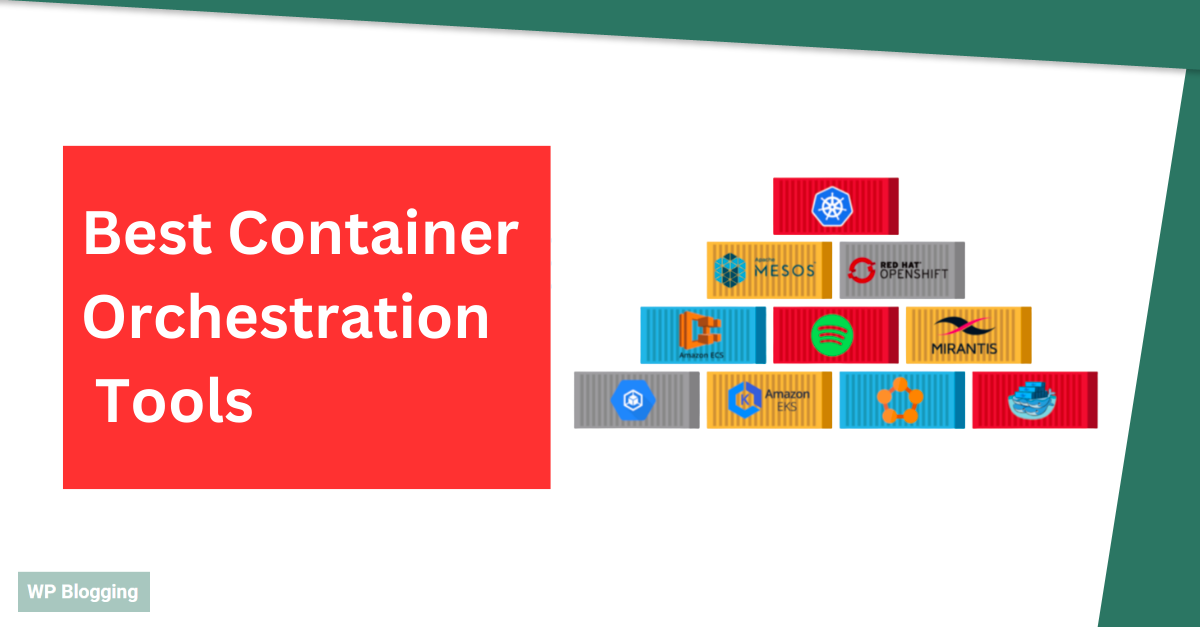
This guide will mainly cover the same topic about Container Orchestration Tools. So, let’s Dive in!!!
Table of Contents
ToggleWhat Is Container Orchestration?
The Container Orchestration tool is used when we need help with the management of containers and microservices at scale.
This helps the developers to make the containers’ distribution throughout a cluster, getting them scaled, and maintaining the health of these containers over time.
The configuration of an app is specified in a YAML or JSON file. This file helps with providing instructions in the configuration management tool, and focuses on how to set up a network, where to find container images, and also where to store the logs.
Whenever there is a need for a new container to be deployed, the application automatically schedules the process of deployment to the specified cluster and chooses the best host based on the provided criteria.
After that, the container orchestration tool then controls the lifecycle of the container, which is generally dependent on the specifications or parameters in the compose file.
In simple words, you can refer to container orchestration as the management of containers, the applications that run inside of them, and their activities. The usage of these tools is particularly important as container-based settings get bigger and more complex, which is too hard to handle.
You should use container orchestration for its major features, one of them being flexibility. You must take advantage of the business and operational advantages of container technology with the flexibility provided by container orchestration.
Examples of common work of container orchestration are:
- Resource configuration and scheduling.
- Container provisioning and deployment.
- Container availability in the case of a failure.
- Changing the scale (up and down).
- Load distribution.
- Routing of traffic.
- Containers and their hosts are being monitored.
- Containers can communicate securely with one another.
List of Best Container Orchestration Tools 2025
Below is the list of the Top Container Orchestration Tools-
Kubernetes
As we have talked about earlier, Kubernetes is what comes to mind when we think about containers. And Kubernetes indeed is one of the best Container Orchestration Tools.
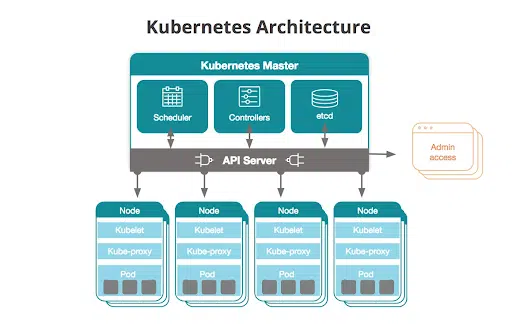
Before Kubernetes, Docker was known to be the best Container Orchestration Tool, but recently the leading platform is Kubernetes.
Kubernetes is ideally useful for the management process of container workloads at scale because it is extremely extensible. You must know that we refer to Kubernetes as a hybrid cloud solution because it can run on-premises, and also in the cloud.
DevOps engineers get a lot of help from Kubernetes as they get relieved from the workloads without having to write JavaScript, Ruby Code, Python, etc. Instead, they can make use of the YAML deployment files and kubectl command-line tools to get their task done easily.
Kubernetes has a large community of SIGs aka special interest groups that concentrate on a variety of subjects like creating new features and trying to enhance the Kubernetes user interface and experience.
Mirantis Kubernetes Engine
Mirantis Kubernetes Engine helps you with the Swarms and Kubernetes Clusters getting done with their upgradation, quick build-ups, configurations, and more. This platform will provide you with full-stack management for the enterprise container solution.
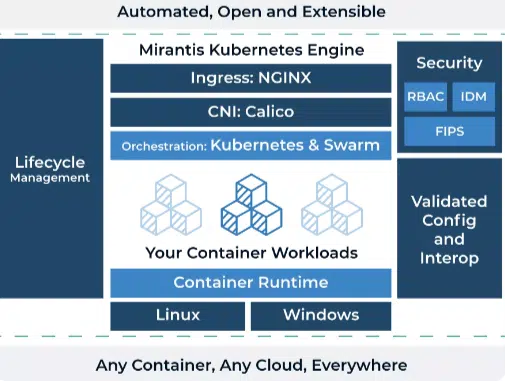
Mirantis can remotely manage Kubernetes or Swarm stack entirely. This Container Orchestration Tool is also an open-source tool and an extensible platform that you can use to avoid vendor lock-in.
Overall Mirantis Kubernetes Engine continuously improves your system.
MKE allows both Kubernetes and Swarm orchestrators to use its services in the same cluster. Linux and Windows users can also easily implement Mirantis’ container method.
Mirantis Kubernetes Engine supports the Microsoft Azure, Equinix Metal, and AWS workloads for container security and compliance. Mirantis provides customized RBAC, continuous compliance, and two-factor authentication
Key features:
- Mirantis uses standard image builds to simplify container administration.
- Through the use of different containers for each program, Mirantis isolation provides security.
- This platform enables cross-platform portability of the application.
- Continuous integration is possible with Mirantis Drivetrain, which increases the speed of deployment.
Red Hat OpenShift
OpenShift gives another perspective to the developers in container management and orchestration by providing them with an easy-to-use Container Orchestration Tool.
Red Hat OpenSHift supports both self-managed and cloud-based container orchestration.
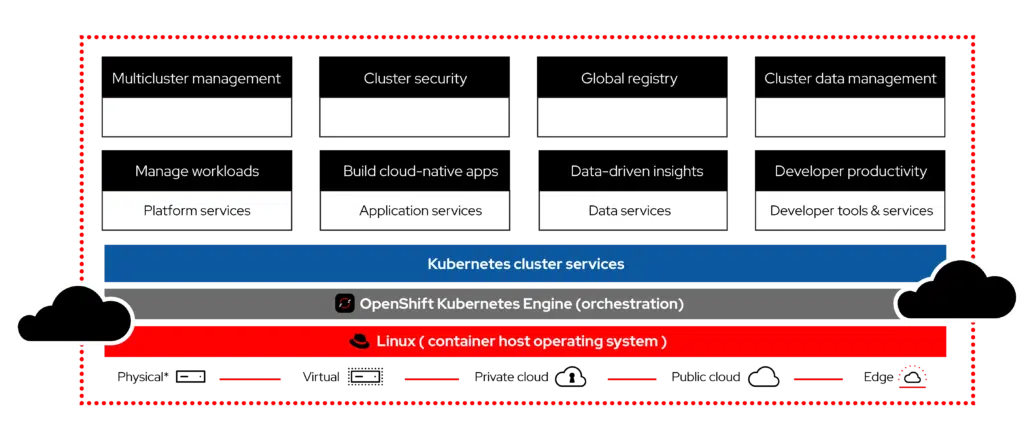
The function of this platform includes a containerization solution as well as a Platform-as-a-Service. It is interesting to know that some parts of this also got built on Docker.
The OpenShift Container Platform’s advantages include-
- Top-notch security.
- Integrated monitoring.
- Policy management is universal/singular.
- Compatibility is provided with the Kubernetes container workloads.
- Self-service provisioning.
- Pre-installed Networking plugins.
- OpenShift’s communication with a variety of platforms results in no risk of vendor lock-in.
This platform also supports Node.js, Ruby, Go, PHP, Python, Perl, & Java. OpenShift can be an excellent choice for businesses that are familiar with using Red Hat products.
Key Features:
- OpenSHift has built-in Jenkins pipelines that streamline processes, which help in providing quicker output.
- This platform also has a built-in container runtime called CoreOS.
- It supports SDN.
- OpenShift supports Self-service by providing several development and operational tools.
Its Embedded Operator Hub gives administrators quick access to third-party solutions. - OpenShift is an Open-Source platform, where you do not need to have a vendor lock-in commitment.
Helios
Spotify has a Helios tool that helps developers in the process of Orchestration of the Docker containers. This is done by distributing them over numerous servers.
If you are a developer, you are going to love Helios as it provides a practical approach and has several functions that help in the enhancement of CI/CD pipelines.
You do not need to have a specialized operating system to control the workflow of your development process. This platform handles various work for you like the cloud services, or network topologies to manage the containers and other related things.
Helios can also maintain track of activities like previous restarting, deployments, and changed versions in the cluster history. In this way, it becomes easier for the developers to quickly find the source of a problem or a security issue by using an HTTP API Client.
The developers can use the Command Line Interface for the same purpose.
Key Features-
- Effective integration with DevOps.
- The vendor-agnostic supports any network or platform.
- Helios uses single-node as well as multi-node instances.
- Apache Mesos is not necessary for Helios to work.
- It is not reliant on routers and load balancers.
Amazon Elastic Container Service (Amazon ECS)
On Amazon’s Elastic Container Service instances, businesses may quickly install and run container clusters. Amazon ECS refers to an orchestration platform that is trustworthy, protected, and manages many tasks at a time.
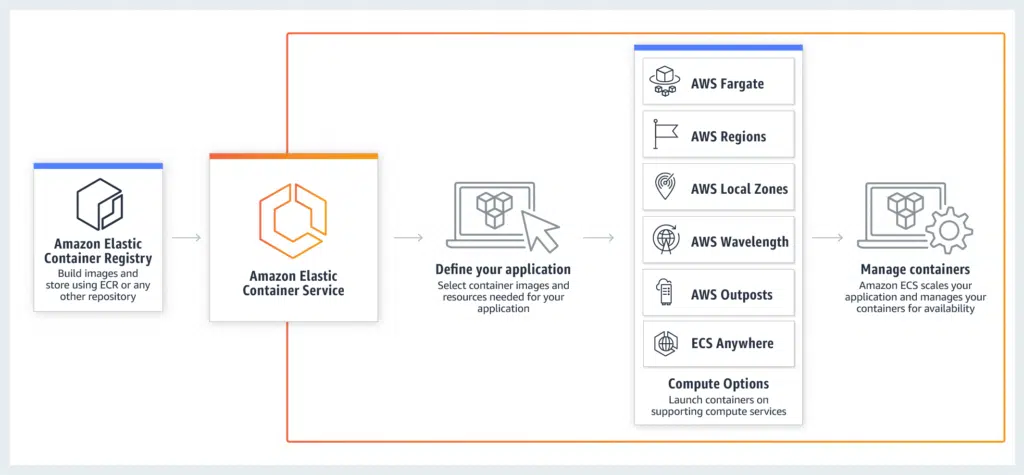
This makes it entirely appropriate for delicate and mission-critical applications.
The serverless computing platform Amazon Fargate helps developers to specify resource requirements without the need for server deployment. It seamlessly integrates with Amazon ECS.
A big piece of advice for all the businesses out there is that they should concentrate on application simplification rather than infrastructure management.
Key features:
- ECS Supports Fargate manages the servers and leaves you with no hassle.
- Capacity providers dynamically identify the number of required computing resources.ECS makes Amazon VPCs for containers.
- Prevents any resource sharing between tenants.
- Applications must work together across many environments by using the Container Registry.
Apache Mesos
Apache Mesos is an amazing cluster management tool with effective container orchestration capabilities. Being an open-source platform, it allows a simple process to pool and distribute resources among distributed frameworks.
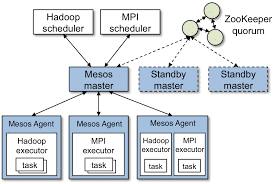
Apache Mesos uses the Marathon API and Chronos Scheduler to scale services and balance the loads. As a developer, if you want to establish inter-framework rules, then use Mesos for the best of its use.
Key features:
- Linear Scalability helps to deploy thousands of nodes.
- Building new Java, C++, and other applications through API
- Fault-tolerant master replication through Zookeeper.
- A graphical user interface keeps a track of the state of your clusters.
Google Kubernetes Engine (GKE)
Using Google infrastructure, you can deploy, manage, and grow containerized projects and managed frameworks. Kubernetes uses its tools and commands to carry out a lot of administrative tasks, and more.
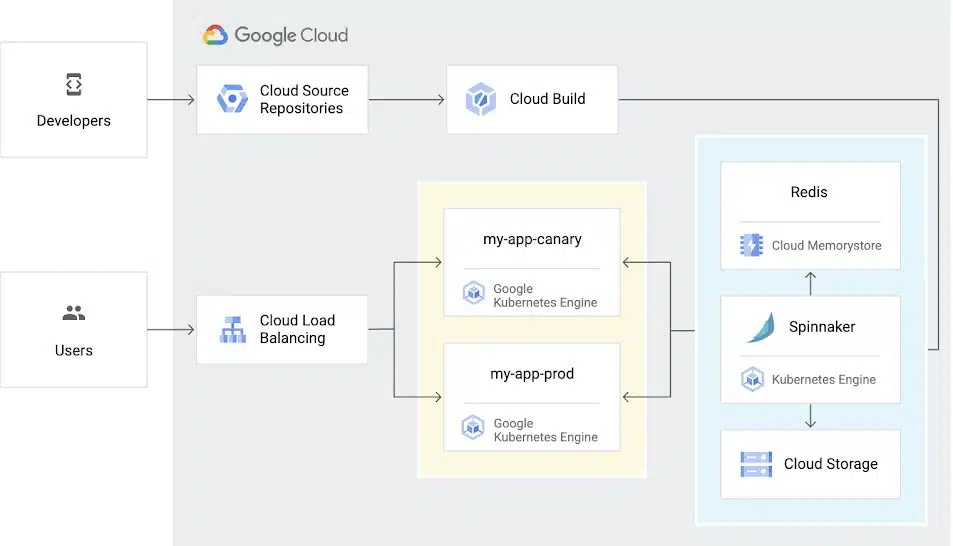
These tasks include keeping track of the status of your workload, deploying, managing containerized apps, executing, making policies, and carrying out other administrative tasks.
Advantages of using Google Kubernetes Engine include:-
- Scalability of 15,000 nodes.
- High speed performance.
- Multi-zone support.
In the hosted environment, you must note that Google technicians maintain things like rolling upgrades. Now you don’t need to fuss about the clusters and infrastructure because they will be taken care of through Autopilot mode only.
On the other hand, standard mode gives you all control over cluster administration and node configuration.
Azure Service Fabric
You may define Microsoft’s Azure Service Fabric as a Platform-as-a-Service product that streamlines container deployment, packaging, and maintenance so that developers can concentrate on creating business logic and applications.
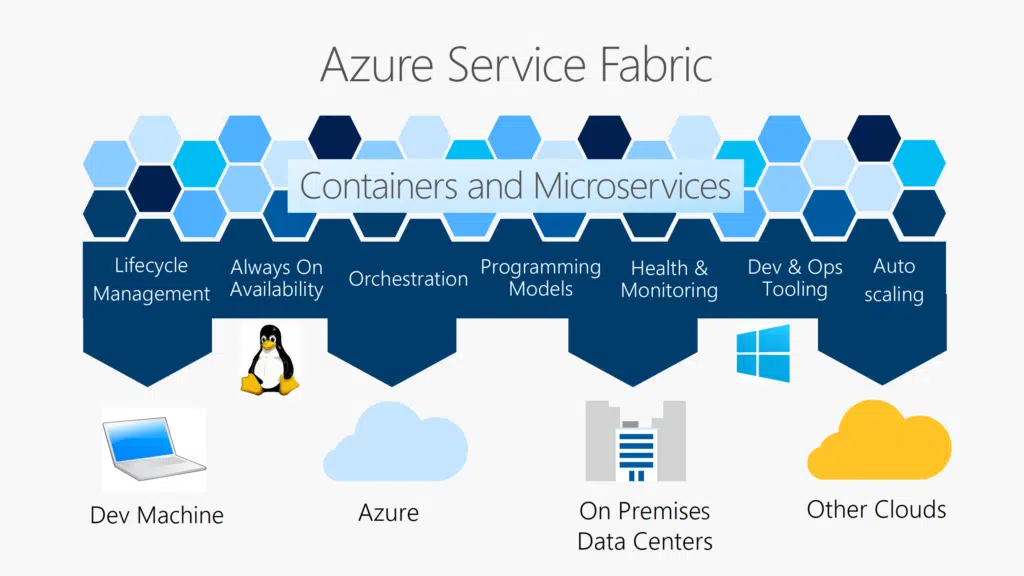
Businesses may handle both stateful and stateless services by using Service Fabric to deploy and manage microservices across distributed workstations. This platform helps you in building and managing clusters across a variety of environments.
These environments include Linux, Azure on-premises, Windows Server, Azure on-premises, and more.
Key Features-
- This platform is for legacy apps to lift and shift migration using guest executables.
- No need for backend provisioning.
- Management of containerized apps on both stateful and stateless services.
- Azure Service Fabric enables a Serverless Compute experience.
- Running distinct tracks on various servers that house different microservices, makes applications more robust.
- The data-aware feature improves workload performance and reduces latency.
Amazon Elastic Kubernetes Service (EKS)
Amazon Elastic Kubernetes Service is universally known for its great assistance to developers. Enterprises can deliver highly trustworthy, secure, and scalable clusters by using EKS. It looks after the process that includes building, deploying, and scaling Kubernetes applications locally or in the AWS cloud.
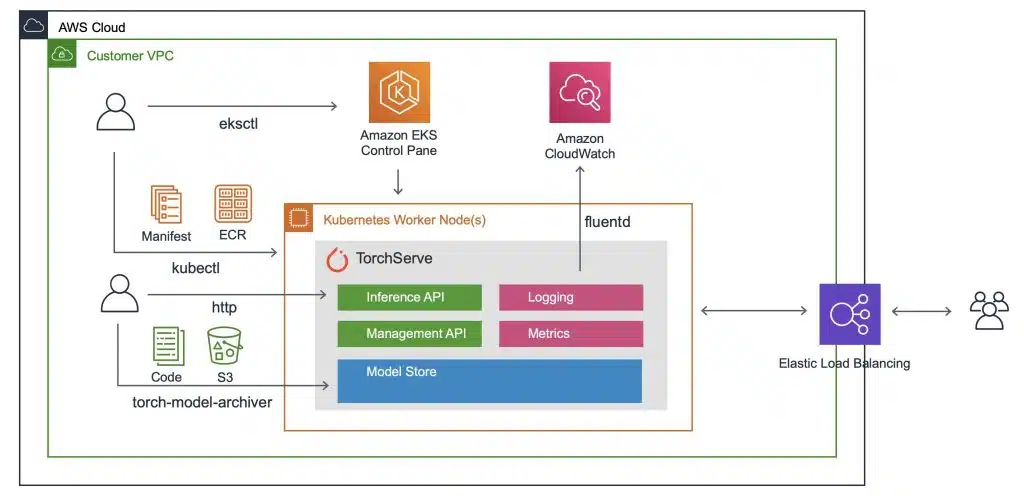
The Amazon EKS regulates tasks related to patches, updates, and node provision.
EKS does this by eliminating all tedious manual configuration tasks and Kubernetes cluster management tedium. This is done to lessen the effort needed to do repetitive tasks that you need to operate your application.
You can use all of the currently available Kubernetes plugins and tools for your application because the fact that EKS is a Kubernetes upstream product. This service helps in automatically deploying Kubernetes with three master nodes across multiple availability zones for optimum reliability and resilience.
Key Features:
- EKS and Kubernetes cluster interoperability enable a simple, code-free migration to the AWS cloud.
- A flexible Kubernetes Control Plane is offered by AWS EKS which is accessible in all regions.
- Expand Kubernetes cluster’s capabilities with EKS add-ons.
- EKS automatically installs updates and identifies malfunctioning masters.
- EKS allows you to manage apps directly from Kubernetes by using AWS Controllers for Kubernetes.
- It is very efficient to quickly grow, build, update, and terminate nodes in your EKS cluster just by using one command.
Docker Swarm
As discussed earlier, you must recall that Docker Swarm is the native container orchestration tool for Container Orchestration. A Docker Swarm is a collection of computers that is physical or virtual, and working together to run Docker programs.
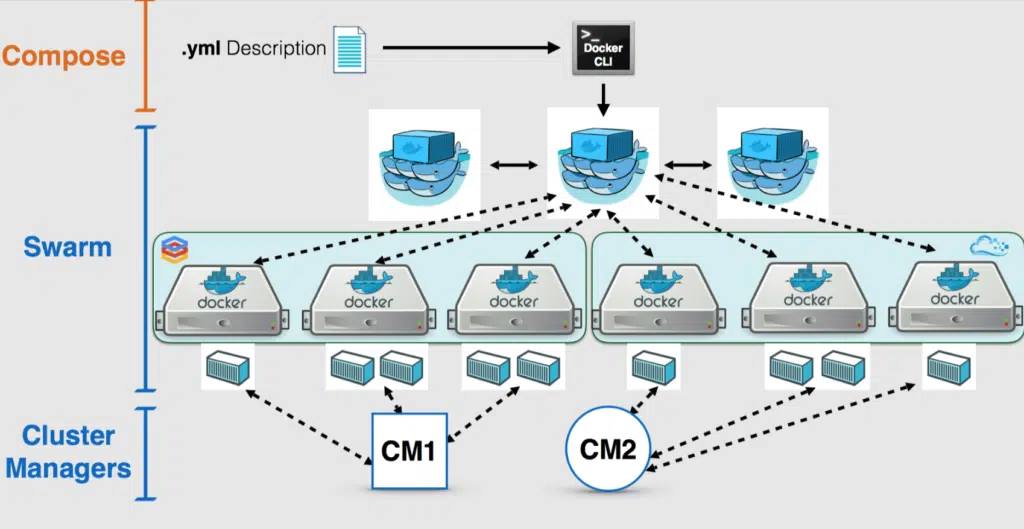
The features of Docker Swarm include overseeing the activities of the swarm and controlling the interactions of containers placed on various host machines.
A very portable and agile application may be created with Docker Swarm, which also offers redundancy to guarantee your applications’ high availability. Swarm managers also distribute workloads to the best hosts, which ensures that the application load balancing is effective and efficient.
The Swarm Manager helps a cluster maintain its desired state by adding and removing worker tasks to provide optimal scaling.
Key Features:
- Docker Swarm’s manager nodes distribute jobs to the most suitable hosts.
- This platform makes use of redundancy to guarantee high service availability.
- The swarm containers do not weigh heavy, and they are also portable.
- Integrated Docker Ecosystem makes container management simpler.
- It does not require the installation of any additional plugins.
- Excellent scalability when workload increases.
- Docker Swarm’s distributed environment allows for decentralized access and cooperation.
Managed Vs. Self-Hosted Container Orchestration Tools
It can be confusing at times to decide whether to choose Managed or Self-hosted Container Orchestration Tools. The decision lies entirely to be made by the organization, but the thing is that we must assure that we choose something that is most suitable for us.
Below are the advantages, and disadvantages of both Managed and Self-hosted Container Orchestration Tools-
Managed Container Orchestration Tools
| Advantages | Disadvantages |
| Allow provisioning in just a click | You do not get any control over the control plane. |
| It allows integration with the native cloud platform services | Cloud Provider will provide you limited options and you have to stick with them. |
| It has minimum administrative overhead. | |
| This tool has High Scalability and High Availability. | |
| It provides an Enterprise-grade security along with the Compliance | |
| You get a Technical support for 24/7 | |
Self-hosted Container Orchestration Tools
| Advantages | Disadvantages |
| This allows complete control over the tool or platform. | You will have to provide a huge engineering effort on custom automation. |
| Provides flexibility to your work. | There will be a need for a dedicated support team. |
| It needs a custom scaling setup. | |
| Need experts in the team for designing, setup, upgradation, and maintenance of the cluster. |
Conclusion: Which Container Orchestration Tool should you choose?
Hopefully, this guide has helped you in getting to know about all the important Container Orchestration Tools, their features, and more.
Kubernetes is the most popular option when it comes to using such a tool and getting your development work done efficiently.
You can choose the extended version of Kubernetes versions GKE and EKS to get your things done. Make sure to choose the right tool so that you can make the best use of your potential.
You can go through the given difference table between managed and self-hosted Container Orchestration Tools to decide which one is going to work the best for you.
Good advice would be to choose the Hosted Container Orchestration Tools.
Also read:
FAQs:
What is the most popular Container Orchestration Tool?
Kubernetes is one of the most popular Container Orchestration Tools leaving behind Docker Swarm, and other possible options. Every tool has its benefits, but Kubernetes can be the most suitable one for you.
What could be the possible difference between Kubernetes & Openshift?
Kubernetes is ideally useful for managing container workloads at scale because it is extremely extensible, runs on-premises or in the cloud, and also is a hybrid cloud solution.
On the other hand, OpenShift gives another perspective to the developers in container management and orchestration by providing them with an easy-to-use Container Orchestration Tool that supports both self-managed and cloud-based container orchestration.
How do I choose a container orchestration tool?
The choice of Container Orchestration Tool is entirely dependent on various factors like the size of the team, the organization’s budget, the available SMEs, Security compliance, the compatibility of the applications, and more.
So, it is entirely your choice to decide which Container Orchestration Tool you would need.